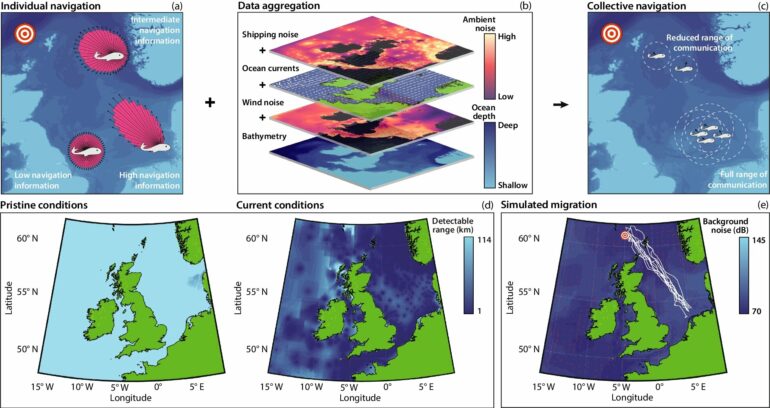In 1490, Leonardo da Vinci wrote, “If you cause your ship to stop and place the head of a long tube in the water and place the outer extremity to your ear, you will hear ships at a great distance from you.”
We now have an in-depth understanding of the physics of why sound travels a greater distance under the water than in the air.
But half a millennium on from da Vinci’s observation, the quiet waters of the Renaissance have been replaced by oceans congested with vessels hundreds of meters long.
The noise pollution that stems from this traffic has become a pressing issue for the many marine animals—including whales—that rely on sound to communicate.
Over the past few years, our research team has been developing mathematical models to investigate how this noisy ocean soundscape impacts whale migration.
In our latest research publication in Movement Ecology, we find that, depending on the future level of noise, this impact could range from mild, where whales take a bit longer to reach their destination, to extreme, where migration fails completely.
Living among the noise
Because light doesn’t travel very far underwater, a lot of marine animals rely on sound to sense the world around them.
Whales are capable of complex vocalizations—from the famous songs of blue whales and humpback whales to the quirky “boing” calls of minke whales.
However, ocean conditions have changed a lot from the pre-industrial era in which whales evolved. Ambient noise levels in the ocean have increased by more than 20 decibels since 1950—this represents a 100-fold increase in the background noise intensity.
Going forward, we expect further increases in shipping activity, resource extraction and offshore construction, each of which will contribute to additional ambient noise.
We know this noise has a negative effect on marine life—from increased stress levels, which have been linked to stranding events, to an inability to locate food or a mate.
However, we don’t fully understand how it impacts whale behavior, particularly during their annual long-distance migrations.
Avoidance, confusion or solitude?
We’ve proposed three main ways that noise could impact whales and their migrations—solitude, avoidance and confusion.
First, noise levels could reduce the area over which whales can communicate (solitude). Second, it could induce stress and cause whales to avoid certain areas (avoidance). And finally, noise could reduce the ability to identify their surroundings (confusion).
We can all relate to this: it’s harder to have a conversation at a loud concert than at the park (solitude); if someone is drilling outside your office window, you’ll probably be a bit stressed and would prefer to work from home (avoidance); and, if you’re trying to find someone based on where their voice is coming from, it becomes much harder if there are lots of other noises (confusion).
The role of mathematics
Obviously we can’t keep whales in a lab to test their noise sensitivity, so mathematical models are a useful way to test these ideas.
We build models by writing algorithms that capture our knowledge and assumptions about whale behavior and the physics of sound transmission. We can then make changes to the inputs of the model to see how its predictions change.
For example, we could simulate migration before and after a 50% increase in shipping traffic, which would be very difficult to do in real life.
Our latest research publication extends our previous model of collective whale navigation from one response, confusion, to include the three main responses to noise—avoidance, confusion and solitude.
Researchers haven’t yet been able to measure the relative impact of each type of response in the wild, so we don’t know which is dominant. But we can test this with our model by adjusting the inputs to see how the overall migration behavior changes if avoidance, confusion or solitude is the primary response to increased noise.
Our model then predicts the migration paths of individual whales and relevant statistics like the average journey time and the number of whale calls that can be detected by other whales.
We include information about shipping traffic, wind noise, ocean currents, construction activity and ocean depth to give our whales a realistic environment to navigate through.
We focused on the North Sea because there is lots of data available on shipping traffic, resource extraction activity and whale sightings, and we know there is significant offshore construction activity planned.
Changes in migration behavior
Our model showed distinct and concerning changes in migration behavior, depending on which noise impact has the biggest influence on whale decision making.
If the primary impact of noise pollution is solitude, the effect is mild: migration still occurs but is slower.
If the primary impact is confusion, the effect can range from mild to severe. Migration might simply be slower or, if the noise is especially severe, migration may fail, with the whales drifting off-course due to strong currents and a lack of information on which direction to travel.
If the primary impact of noise pollution is avoidance, the effect can range from mild to extreme. If there are only small regions of high noise, migration will still occur, and the whales will simply skirt these regions.
But as the noise continues to increase, these high noise regions become larger and larger, until ultimately the migration path is cut off and migration completely fails.
In the wild, this would be catastrophic for that population of whales.
Fortunately, we do not currently see migration failure for entire populations: this example is simply a prediction arising from programming our model for an extreme future scenario where noise levels continue to increase unabated.
It is also important to note that our model predictions are contingent on the accuracy of our model—how well it captures whales’ biology and environment. But now that we have this modeling data, it gives other researchers something to test by direct observation.
We next plan on adapting the model to look at whale migrations along the east coast of Australia, such as the migration of humpback whales from the Southern Ocean to the Great Barrier Reef.
With the ever-increasing shipping traffic that underpins global trade and the need for the construction of offshore wind farms to support the transition to renewable energy, it has never been more important to understand the consequences of the choices that we make, so that we can ensure that we co-exist sustainably with our spectacular marine wildlife.
More information:
Stuart T. Johnston et al, Avoidance, confusion or solitude? Modelling how noise pollution affects whale migration, Movement Ecology (2024). DOI: 10.1186/s40462-024-00458-w
Provided by
University of Melbourne
Citation:
How whales struggle to navigate in a sea of noise pollution (2024, April 9)



